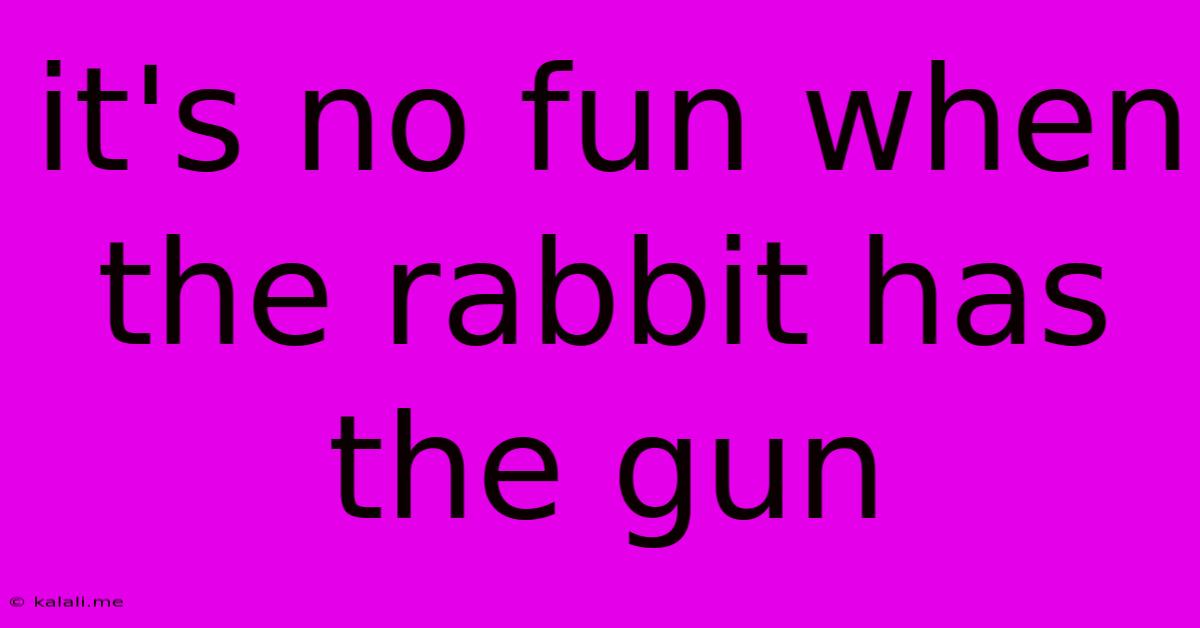It's No Fun When The Rabbit Has The Gun
Kalali
May 25, 2025 · 3 min read

Table of Contents
It's No Fun When the Rabbit Has the Gun: Reversing Power Dynamics in Storytelling
This article explores the fascinating narrative trope of "the rabbit having the gun," where the traditionally weaker or marginalized character gains power and agency, often subverting expectations and delivering satisfyingly unexpected outcomes. We'll delve into the reasons this trope resonates with audiences, its effective implementation, and its potential pitfalls.
The Classic Power Imbalance: Stories often rely on established power dynamics. The hero, typically strong and capable, confronts an antagonist, usually weaker or more vulnerable. Think David versus Goliath – a clear imbalance, resolved with the underdog's triumph. But what happens when we flip this dynamic on its head? What if the rabbit, usually the hunted, wields the power?
Why It's So Satisfying: The "rabbit with the gun" trope taps into deep-seated desires for justice, revenge, and the subversion of oppressive systems. Seeing a marginalized character reclaim their power is deeply cathartic for the audience. This is especially potent when the character's power isn't merely physical, but involves cleverness, manipulation, or a unique understanding of the situation. It's a thrilling reversal of fortune that defies expectations and provides a sense of empowerment to both the character and the viewer.
Examples in Popular Culture
This narrative structure is found across various media. Consider these examples:
-
The underdog's victory: Many sports movies feature this trope, where a seemingly inferior team or athlete overcomes overwhelming odds to achieve victory. The initial power imbalance is clear, making the ultimate triumph all the more satisfying.
-
The clever servant: In many fairy tales and novels, a seemingly powerless servant or slave uses their wit and cunning to outsmart their oppressors, often achieving a position of power or freedom.
-
The revenge narrative: Stories focusing on revenge often employ this trope. The initially victimized character utilizes their newfound strength to exact revenge, providing a sense of closure and justice for the audience.
-
The unexpected twist: Mystery and thriller genres frequently use this technique, revealing a seemingly harmless character as the ultimate mastermind, turning the tables on the expected narrative.
Crafting the "Rabbit with the Gun" Narrative:
Successfully executing this trope requires careful planning:
-
Establish the imbalance: The audience needs to understand the initial power disparity. Clearly define the rabbit's initial vulnerability and the power held by the antagonist.
-
Justify the power shift: The audience needs a believable explanation for how the rabbit gains power. This could involve clever planning, unexpected opportunities, or the acquisition of a powerful weapon (literally or metaphorically).
-
Maintain suspense: The journey towards the rabbit gaining the upper hand shouldn't be predictable. Introduce obstacles and challenges that keep the audience engaged.
-
Explore the consequences: The rabbit's newfound power may not resolve all problems. Consider the moral and ethical implications of their actions and how the power shift impacts the overall narrative.
Potential Pitfalls to Avoid:
-
Unrealistic power shifts: The rabbit's sudden acquisition of power needs to feel justified and believable, not deus ex machina.
-
Overly simplistic revenge: While revenge can be a driving force, it should not be the sole focus. Explore the character's motivations and the broader implications of their actions.
-
Ignoring the consequences: The rabbit's actions should have consequences, even if they are positive ones. Ignoring the fallout undermines the story's depth and realism.
The "rabbit with the gun" trope, when executed effectively, offers a powerful and satisfying narrative arc. By understanding its strengths, pitfalls, and potential applications, writers can create compelling and resonant stories that resonate deeply with their audiences. It’s a reminder that even the most vulnerable can surprise us, and that sometimes, the most satisfying stories are those that challenge our expectations.
Latest Posts
Latest Posts
-
Mac Os X List Usb Devices
May 25, 2025
-
Download Attachments From Multiple Emails Gmail
May 25, 2025
-
What Does In Residence Mean For College
May 25, 2025
-
Send Me A Photo Of You
May 25, 2025
-
Insufficient Access Rights On Cross Reference Id
May 25, 2025
Related Post
Thank you for visiting our website which covers about It's No Fun When The Rabbit Has The Gun . We hope the information provided has been useful to you. Feel free to contact us if you have any questions or need further assistance. See you next time and don't miss to bookmark.